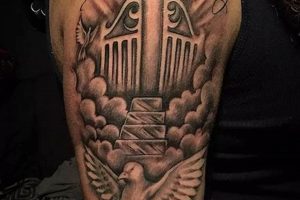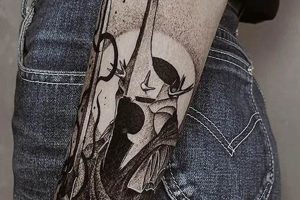Symbolic body art reflecting personal belief systems often incorporates imagery derived from religious texts, spiritual figures, or abstract concepts representing devotion, hope, and guidance. Examples include crosses, praying hands, scriptural verses, or symbols like the lotus flower or Om.
These permanent expressions of belief can serve as powerful reminders of one’s values, providing comfort, strength, and a connection to something larger than oneself. Historically, permanent markings have signified spiritual affiliation across diverse cultures, from indigenous tribal rituals to ancient religious practices. The modern resurgence of this tradition highlights the enduring human need to externalize internal convictions.
Exploring the rich tapestry of symbolic designs provides a deeper understanding of how individuals translate their convictions into visual representations. The subsequent sections will delve into popular design choices, considerations for placement and artistry, and the cultural significance embedded within these enduring emblems of faith.
1. Symbolism
Symbolism lies at the heart of designs intended to represent faith. The chosen imagery acts as a visual shorthand for complex spiritual concepts, beliefs, and values. This connection between image and meaning allows individuals to externalize deeply held convictions, making the intangible tangible. A cross, for example, signifies Christianity, representing sacrifice and redemption. The Star of David embodies Judaism, symbolizing the relationship between God and humanity. These symbols carry weight and significance beyond their visual form, resonating with personal narratives of faith.
Understanding the historical and cultural context of symbolic imagery is crucial for creating meaningful body art. A lotus flower, while aesthetically pleasing, carries deep spiritual significance in Buddhism and Hinduism, representing purity and enlightenment. Incorporating such symbols without understanding their cultural weight can lead to misinterpretation or misappropriation. Careful research ensures the chosen design accurately reflects the intended meaning and respects its origins. For instance, Sanskrit script or specific deities should be chosen with reverence and awareness of their religious context.
Effective symbolic representation requires thoughtful consideration of both personal meaning and cultural sensitivity. The power of these designs lies in their ability to communicate profound beliefs concisely and visually. Careful selection, informed by research and personal reflection, ensures the chosen symbolism resonates authentically and respectfully represents the individual’s faith journey. Ultimately, the most impactful designs are those that connect deeply with personal belief while acknowledging the broader cultural tapestry of spiritual expression.
2. Placement
Placement of body art expressing faith carries significant weight, influencing both personal meaning and public perception. Consideration of visibility, symbolism, and practicality is crucial in choosing the optimal location for a design. The placement itself can amplify or alter the intended message, transforming a simple image into a powerful statement of belief.
- Visibility
Visibility plays a key role in determining the impact of a design. Highly visible placements, such as hands or forearms, can serve as constant reminders of one’s faith, inviting conversations and openly expressing beliefs. Conversely, less visible placements, like the back or ribcage, offer a sense of personal intimacy, keeping the expression of faith more private and introspective. The level of visibility often aligns with the individual’s comfort level in sharing their beliefs with the world.
- Symbolic Resonance
The location on the body can add layers of symbolic meaning to the design. A tattoo placed near the heart can emphasize the deeply personal and emotional connection to one’s faith. Placement on the wrist, a common pulse point, can represent the lifeblood of belief. Thoughtful consideration of anatomical placement can enhance the inherent symbolism of the chosen design, adding depth and complexity to its message.
- Practical Considerations
Practicality also informs placement decisions. Certain professions may have restrictions on visible body art, necessitating discreet placement. Additionally, the size and complexity of the design might influence the most suitable location. Larger, more intricate pieces often require larger areas of skin, while smaller, simpler designs can be adapted to various locations. Balancing aesthetic desires with practical constraints ensures the final placement is both meaningful and feasible.
- Cultural Significance
In some cultures, specific body parts hold particular spiritual significance. Researching these cultural nuances can further inform placement decisions, ensuring the chosen location aligns with the intended message and avoids unintended misinterpretations. Understanding these cultural connections adds another layer of depth and respect to the placement of faith-based body art.
Ultimately, the placement of a design expressing faith is a deeply personal decision. Careful consideration of visibility, symbolic resonance, practical constraints, and cultural context allows individuals to choose a location that amplifies the intended message and creates a powerful, lasting tribute to their beliefs.
3. Design
Design in faith-based body art transcends mere aesthetics; it represents the visual embodiment of deeply held beliefs. Effective design choices amplify the intended message, transforming abstract concepts into powerful, personal statements. Careful consideration of style, composition, and artistic elements ensures the final design resonates authentically and respectfully represents the individual’s faith journey.
- Style
Style significantly impacts the overall aesthetic and message conveyed. Minimalist designs, characterized by clean lines and simple forms, offer a contemporary, understated approach. Intricate, detailed designs, often incorporating realistic imagery or elaborate patterns, can evoke a sense of traditional reverence. Scriptural passages, rendered in elegant calligraphy, provide a direct and personal connection to sacred texts. Choosing a style that aligns with personal aesthetics and the intended message is crucial for creating a cohesive and impactful design. A minimalist cross, for example, might represent a quiet, modern faith, while a detailed depiction of a religious scene could signify a deep immersion in tradition.
- Composition
Composition refers to the arrangement of elements within the design, influencing visual flow and balance. A well-composed design guides the viewer’s eye, highlighting key elements and creating a harmonious overall impression. Incorporating elements like negative space, symmetry, or asymmetry can further enhance the visual impact. For example, a circular mandala design might represent wholeness and interconnectedness, while an asymmetrical arrangement of symbols could represent a dynamic, evolving faith.
- Color Palette
Color adds another layer of meaning and emotional resonance to faith-based body art. Black and gray ink offer a timeless, classic aesthetic, suitable for conveying solemnity or reverence. Color can be used strategically to represent specific elements or emotions associated with one’s faith. For instance, blue might represent peace and tranquility, while red could symbolize passion or sacrifice. Understanding the cultural and religious significance of colors ensures appropriate and meaningful choices.
- Incorporation of Personal Elements
Personal elements woven into the design create a unique and deeply meaningful expression of faith. Incorporating meaningful dates, quotes, or symbols relevant to personal experiences further individualizes the design, transforming it from a general representation of faith into a powerful reflection of personal belief. Adding a loved one’s name to a scriptural passage, for example, could represent the shared faith and connection between individuals.
By thoughtfully considering style, composition, color, and personal elements, individuals can create faith-based body art that transcends mere decoration. These design choices, when carefully executed, transform ink and skin into powerful visual narratives of belief, offering a lasting testament to one’s faith journey.
4. Artistry
Artistry plays a pivotal role in translating the deeply personal and often complex concepts of faith into meaningful visual representations. The skilled execution of a design elevates a simple tattoo into a powerful work of art, imbuing it with emotional resonance and lasting impact. The artist’s ability to understand and interpret the individual’s vision is paramount, ensuring the final piece accurately reflects the intended message and resonates authentically with the wearer’s beliefs. A skilled artist can transform a simple cross into a poignant representation of sacrifice by incorporating intricate details, realistic shading, or symbolic imagery.
Choosing a skilled tattoo artist specializing in the desired style is crucial for achieving the desired outcome. Different artists possess unique strengths and specializations, ranging from fine linework and delicate shading to bold, traditional imagery. Researching an artist’s portfolio and discussing the intended design in detail ensures a strong collaborative relationship, fostering a shared understanding of the project’s vision and technical execution. For instance, an artist specializing in realism might be ideal for depicting religious figures, while an artist skilled in geometric patterns could create intricate mandalas representing spiritual concepts. This careful selection process ensures the final piece reflects the individual’s vision and the artist’s technical expertise.
The interplay between artistry and faith extends beyond technical skill, encompassing a deep understanding of cultural and religious symbolism. A knowledgeable artist can provide valuable insights into appropriate imagery, design elements, and placement, ensuring the final piece respects the chosen faith tradition. This collaborative approach avoids potential misinterpretations or cultural insensitivity, ensuring the tattoo remains a respectful and authentic representation of belief. Ultimately, the synergy between a skilled artist and an individual seeking to express their faith results in a powerful, lasting work of art that transcends mere decoration, becoming a visual testament to deeply held convictions.
Tips for Choosing Faith-Based Tattoos
Selecting a design that embodies personal beliefs requires careful consideration. These tips offer guidance for navigating the process thoughtfully and respectfully.
Tip 1: Research Symbolism: Thoroughly research the symbolism associated with chosen imagery. Understanding the historical and cultural context of a symbol prevents misinterpretation and ensures respectful representation. A dove, for example, symbolizes peace in Christianity, while a lotus flower represents purity and enlightenment in Eastern religions.
Tip 2: Consider Placement Carefully: Placement impacts visibility and can enhance symbolic meaning. A tattoo near the heart emphasizes emotional connection, while a wrist placement represents the lifeblood of belief. Practical considerations, like professional dress codes, should also inform placement choices.
Tip 3: Choose a Style that Resonates: Design style influences the overall aesthetic. Minimalist designs offer a modern approach, while intricate details evoke traditional reverence. Scriptural passages provide a direct connection to sacred texts. The chosen style should align with personal aesthetics and the intended message.
Tip 4: Prioritize Artistry: Selecting a skilled artist specializing in the desired style ensures the final piece reflects the intended vision. Researching portfolios and discussing the design in detail fosters a collaborative relationship, crucial for achieving the desired outcome.
Tip 5: Reflect on Personal Meaning: Infuse the design with personal elements to create a unique and deeply meaningful expression of faith. Incorporating meaningful dates, quotes, or symbols relevant to personal experiences transforms the tattoo into a powerful reflection of individual belief.
Tip 6: Plan for Long-Term Care: Body art requires ongoing care. Discuss aftercare procedures with the chosen artist and commit to following these instructions diligently. Proper care preserves the vibrancy and integrity of the design over time.
Tip 7: Consult with Religious Leaders (Optional): For those deeply rooted in a specific faith tradition, consulting with religious leaders can offer valuable insights and ensure the chosen design aligns with religious principles.
Thoughtful consideration of these factors ensures a design that resonates authentically, respectfully represents chosen beliefs, and provides a lasting source of personal meaning.
By following these tips, individuals embark on a journey of translating deeply held convictions into powerful visual narratives, creating lasting tributes to their faith.
Frequently Asked Questions
Addressing common inquiries regarding permanent expressions of faith provides clarity and guidance for those considering such designs.
Question 1: Do all faiths permit body art?
Acceptance of body art varies across religious traditions. Some faiths embrace this form of expression, while others hold reservations or outright prohibitions. Researching specific religious doctrines provides clarity on this matter.
Question 2: What are appropriate symbols for representing specific faiths?
Appropriate symbolism varies significantly based on the chosen faith. Crosses typically represent Christianity, while the Star of David symbolizes Judaism. Researching the specific faith’s iconography ensures accurate and respectful representation.
Question 3: How does one choose a reputable and skilled tattoo artist?
Recommendations, online portfolios, and consultations provide valuable insights into an artist’s skill and experience. Discussing the desired design and observing the artist’s understanding of its symbolic significance helps determine compatibility.
Question 4: What are the typical costs associated with these designs?
Cost depends on factors such as size, complexity, and the artist’s experience. Obtaining quotes from multiple artists allows for comparison and informed decision-making. Prioritizing quality artistry ensures a lasting and meaningful investment.
Question 5: What aftercare procedures are necessary for maintaining the quality of a tattoo?
Proper aftercare, as instructed by the tattoo artist, is crucial for healing and preserving the design’s vibrancy. This typically involves keeping the area clean, moisturized, and protected from sun exposure.
Question 6: Can tattoos expressing faith be removed or altered if beliefs change?
Laser removal or cover-up procedures offer options for altering or removing existing tattoos. However, these procedures can be costly and time-consuming. Careful consideration of design choices minimizes the need for future alterations.
Thoughtful reflection on these considerations ensures informed decision-making and contributes to a positive experience. Further research and consultation with experienced professionals provide additional guidance.
This information serves as a starting point for further exploration of symbolic representation and its enduring connection to personal beliefs. Consultations with religious leaders or experienced professionals can offer additional perspectives and support informed decision-making.
Conclusion
Symbolic representations of belief systems, rendered through permanent body art, offer a powerful means of expressing deeply held convictions. Exploration of design choices, placement considerations, and the importance of skilled artistry reveals the multifaceted nature of these personal expressions. Understanding cultural and religious contexts ensures respectful and authentic representation of chosen beliefs.
Permanent markings serve as enduring testaments to one’s faith journey, offering a source of strength, comfort, and connection to something larger than oneself. Careful consideration of the elements discussed empowers individuals to make informed decisions, transforming personal convictions into powerful, lasting works of art.







